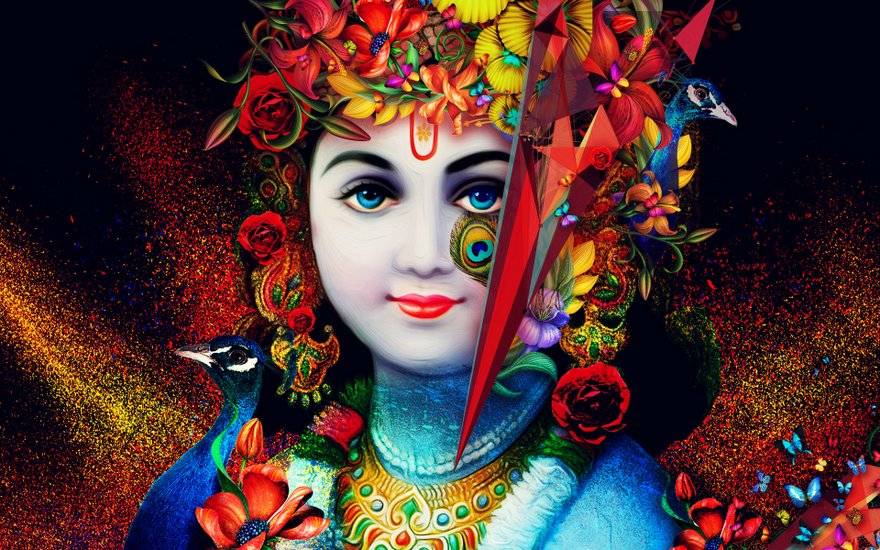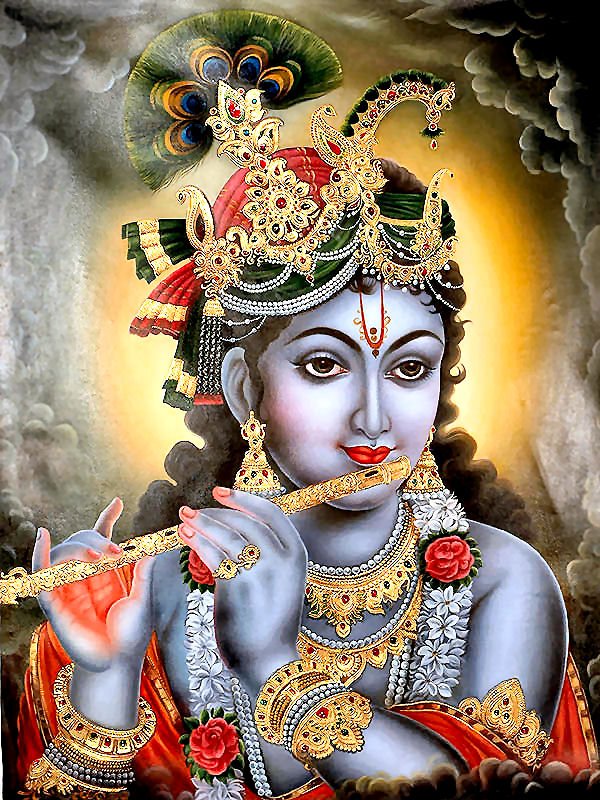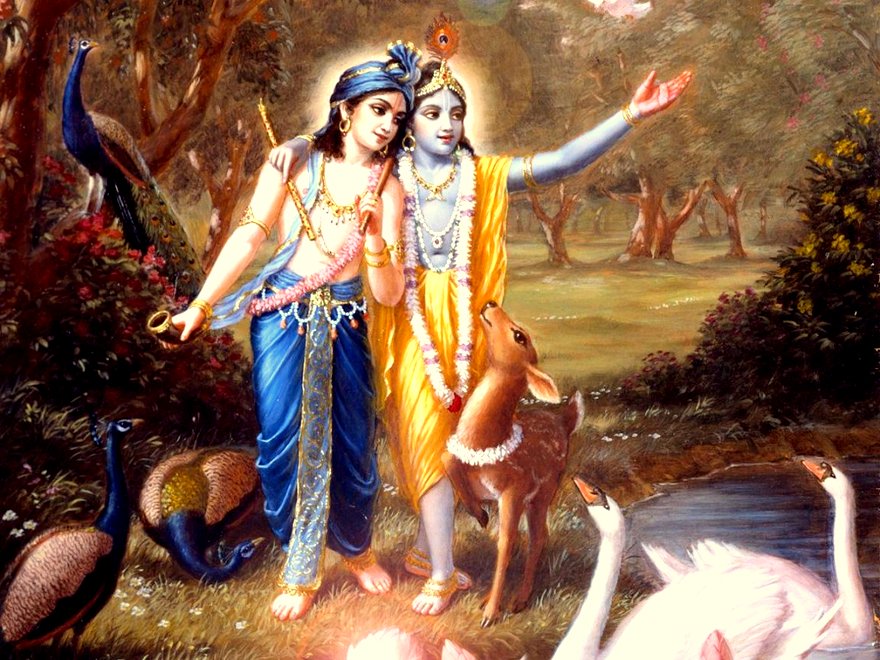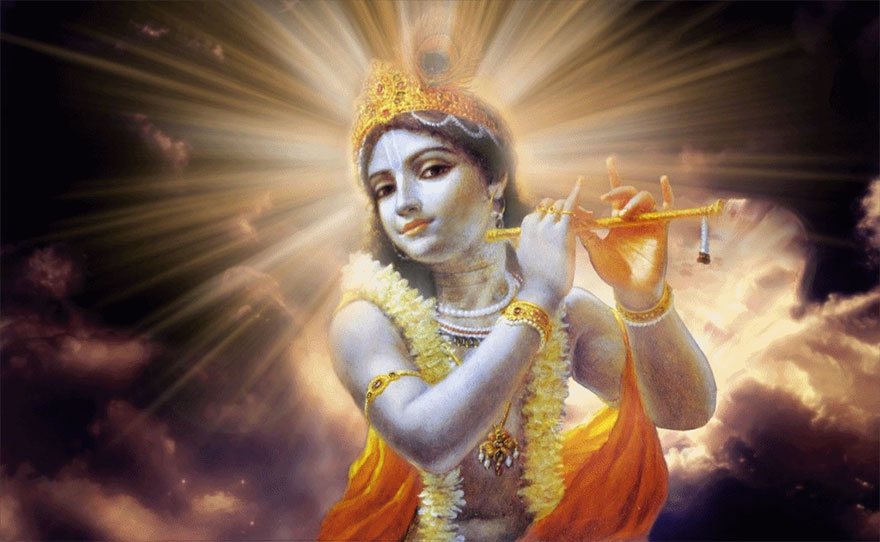Pourquoi est-Krishna bleu
Why is Krishna Blue? Why Not Red or Yellow or Any Other Color?
Posted by Romapada Swami | Oct 20, 2015 | 289 views
Like
Dans le cas contraire, il y a beaucoup de différentes couleurs. Donc akrishna signifie de couleur différente, « pas de krishna, » pas noir. Alors, quel est le réel ? Que nous devons consulter sastra encore une fois, que Krishna, dans combien de catégories de couleur il apparaît ?
Why is Krishna blue? Why not red or yellow or any other color? Why is it that the Absolute Truth has a bluish complexion? It would be best to get some sastric (scriptural) references.
since it is one of these questions that somehow reappears, specifically requesting scriptural references, here are a few. The first was expressed already in the above-cited Answers. Note also that in the final reference cited below, in a lecture of 1975 Srila Prabhupada offers the exact same explanation as you will find in the previous answers (cited above) to explain the word ‘blackish’, or ‘krishna’.
As for the reason behind Krishna’s having a bluish complexion, here is a very beautiful explanation given in Krishna Bhakti Ratna Prakasa by Raghava Gosvami wherein it is said:
atha kaiscid uktam. yadi sva-prakaso lila-rasa-mayah paramatma-svarupas tasmin katham syama-varnatvam sarvatra prasiddham. yatha srutau rupam na vedyam na ca bindunadah ity adi. tad aha
syamabhatvam vidhatte yat
sarva-varno ‘tra liyate
nityam ca prabhavaty eva
kalo ‘smin naiva vidyate
Translation: At this point some may ask: “Why is it that the form of the Personality of Godhead, which He manifests only by His own wish, and which is made of the sweetness of transcendental pastimes, is famous everywhere for its dark complexion?”
Part of the answer to this question may be found in the statement of the Sruti-sastra: “No one can understand even a drop of the Lord’s transcendental form.” Aside from this it is also said: “He eternally manifests the color shyama, within which all colors rest. His complexion is not the material color black.”
Thus from the last verse we see it says “sarva-varnah” which means that the colour shyama is a special color, which is like a composite of all colours. And we notice that if we combine all colours we get a colour which is blackish, but not black.
Srimad Bhagvatam 3.28.13
prasanna-vadanāmbhojaṁ
padma-garbhāruṇekṣaṇam
nīlotpala-dala-śyāmaṁ
śaṅkha-cakra-gadā-dharam
The color of the Personality of Godhead, Krishna, is described here as nilotpala-dala, meaning that it is like that of a lotus flower with petals tinted blue and white. People always ask why Krishna is blue. The color of the Lord has not been imagined by an artist. It is described in authoritative scripture. In the Brahma-samhita also, the color of Krishna’s body is compared to that of a bluish cloud.
The color of the Lord is not poetical imagination. There are authoritative descriptions in the Brahma-samhita, Srimad-Bhagavatam, Bhagavad-gita and many of the puranas of the Lord’s body, His weapons and all other paraphernalia. The Lord’s appearance is described here as padma-garbharuneksanam. His eyes resemble the inside of a lotus flower, and in His four hands He holds the four symbols: conchshell, discus, mace and lotus.
Srimad Bhagvatam 10.8.13
asan varnas trayo hy asya
grhnato ‘nuyugam tanuh
suklo raktas tatha pita
idanim krishnatam gatah
Your son Krishna appears as an incarnation in every millennium. In the past, He assumed three different colors-white, red and yellow-and now He has appeared in a blackish color. [In another Dvapara-yuga, He appeared (as Lord Ramacandra) in the color of suka, a parrot.] All such incarnations have now assembled in Krishna.
Srimad Bhagvatam 11.5.32
krsna-varnam tvisakrsnam
sangopangastra-parsadam
yajnaih sankirtana-prayair
yajanti hi su-medhasah
In the age of Kali, intelligent persons perform congregational chanting to worship the incarnation of Godhead who constantly sings the names of Krishna. Although His complexion is not blackish, He is Krishna Himself. He is accompanied by His associates, servants, weapons and confidential companions.
Bhagavd Gita Lecture of Srila Prabhupada in London 1975
Srila Jiva Gosvami, the most authoritative acarya of our sampradaya, he has explained like this. Krishna-varnam means always chanting Hare Krishna. Krishnam varnayati, describing Krishna, “Hare Krishna, Hare Krishna.” This is description of Krishna, addressing Krishna. So therefore krishna-varnam, or varnam means category.
Just like brahmana-varna, ksatriya-varna. So in that way krishna-varna means He is Krishna, in the category of Krishna. Either you take this meaning or that meaning, krishna-varnam. But Krishna is black, and He is tvisa, by the complexion, akrishna. Akrishna means not Krishna. Now, there are so many colors. So everything is akrishna. That color, all the colors are mixed together, it becomes black.
Otherwise there are many different colors. So akrishna means different color, “not krishna,” not black. So what is the actual? That we have to refer to sastra again, that Krishna, in how many categories of color He appears? That is stated in the Bhagavatam. When Krishna was born, then Gargamuni was calculating about His horoscope, and he said to Nanda Maharaja that “This, your child…” Idanim krishnatam gatah. Suklo raktas tatha pita idanim krishnatam gatah.
“Your child had formerly white color.” White color… Sometimes some critics criticize us that “Krishna everywhere He is black. Why in your temple white?” But it is said that sukla, suklo raktas tatha pita idanim krishnatam gatah: “Your son had other colors also, white and red and yellow, and now He has assumed blackish color.”
A découvrir aussi
- Masonic High Council of Egypt
- Ancien membre des témoins de Jéhovah: « cette religion détruit des vies
- " je suis tum, fait un avec toutes les choses. "Yo soy Tum, hecho uno con todas las cosas.




